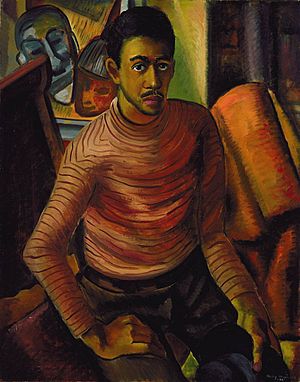Malvin Gray Johnson facts for kids
Quick facts for kids
Malvin Gray Johnson
|
|
|---|---|

Malvin Gray Johnson, Self-Portrait (1934)
|
|
| Born | January 28, 1896 |
| Died | October 4, 1934 (aged 38) |
| Movement | Harlem Renaissance |
Malvin Gray Johnson (born January 28, 1896 – died October 4, 1934) was an American painter. He was born and grew up in Greensboro, North Carolina.
He became famous during the Harlem Renaissance, a time when African-American art, music, and literature thrived in the 1920s and 1930s. Johnson was one of the youngest artists in this important movement.
Early Life and Learning
Malvin Gray Johnson started painting when he was very young. His sister, Maggie, saw his talent and gave him art lessons and supplies. He even won first place for his art in contests at his hometown's yearly fairs.
Later, his family moved to New York City. There, he studied art at the National Academy of Design. His studies were paused when he served in World War I in France. After the war, he returned to his art.
His Art Career
Malvin Gray Johnson was a very talented and flexible artist. He used many different art styles in his work. He learned from famous art movements like Impressionism and Cubism.
Impressionism uses small, thin brushstrokes to show how light changes. Cubism breaks objects into geometric shapes. Johnson's art shows how much he learned from these styles.
He is known for being one of the first African-American artists to paint in the Cubist style. He mixed these modern art styles with subjects about African-American life. He wanted to create truly African-American art.
Johnson's paintings often show scenes from Harlem street life. He also drew inspiration from African sculpture and African-American spirituals (religious songs). He focused on how light, shapes, and colors worked together in his art.
His painting style used strong brushstrokes and bright colors. His forms were often flat and angular. Some people admired how he showed African-American subjects honestly.
Like many artists during the Great Depression, Johnson worked for the Federal Art Project. This project helped artists find jobs during a tough economic time. His art was shown in many exhibitions.
In 1928, he won a prize at a Harmon exhibition. The next year, he won the Otto H. Kahn prize of $250 for his painting. His painting Swing Low, Sweet Chariot won the best picture award in 1929.
Johnson was also featured in a 1930s film called A Study of Negro Artists. This film showed many important artists from the Harlem Renaissance.
Towards the end of his life, in 1933, Johnson created many watercolors. These paintings showed black people in cities and in the countryside. Many of these were set in Brightwood, Virginia. These later works are thought to be some of his best.
Art experts like Margaret Just Butcher and Alain LeRoy Locke praised Johnson's work. They said his paintings showed important parts of the African-American experience.
Famous Artworks
Here are some of Malvin Gray Johnson's well-known paintings:
- Meditation, 1931
- Swing Low, Sweet Chariot, 1929
- Woman Washing
- Negro masks, 1932
- Arrangement, 1933
- Toussaint L'Ouverture, 1933
- Harmony, 1933
- Sailor, 1933
- Nat Turner, 1934
- Postman, 1934
- Negro soldier, 1934
- Self-Portrait, 1934
- Brothers, 1934
- The Elks
- Harriet Tubman and Frederick Douglass
- Negro Pharaoh—Eighteenth Dynasty
- Roll, Jordan, Roll, 1930
- Dixie Madonna
- Ruby
- Red Road
- Convict Labor
Images for kids
See also
 In Spanish: Malvin Gray Johnson para niños
In Spanish: Malvin Gray Johnson para niños


